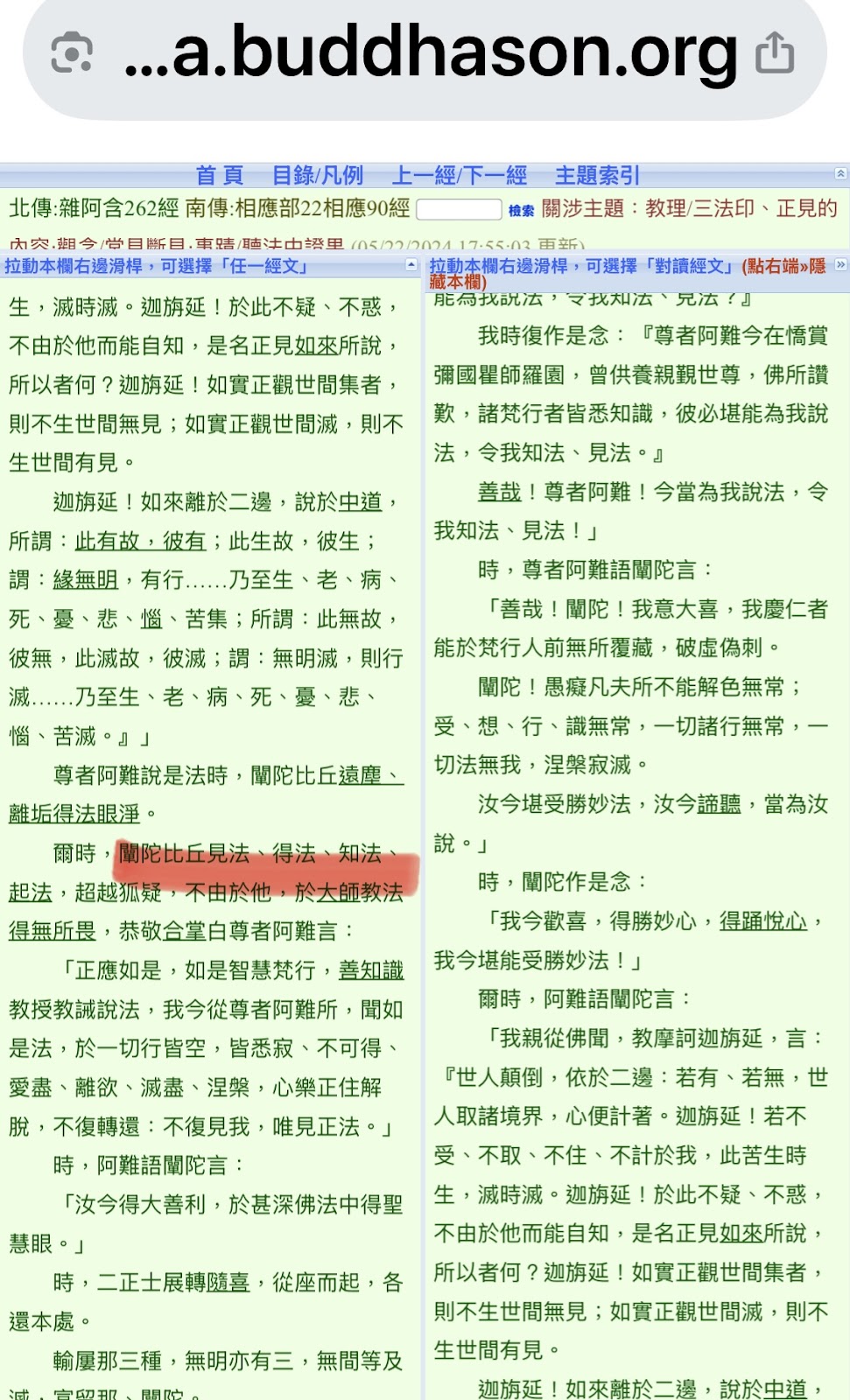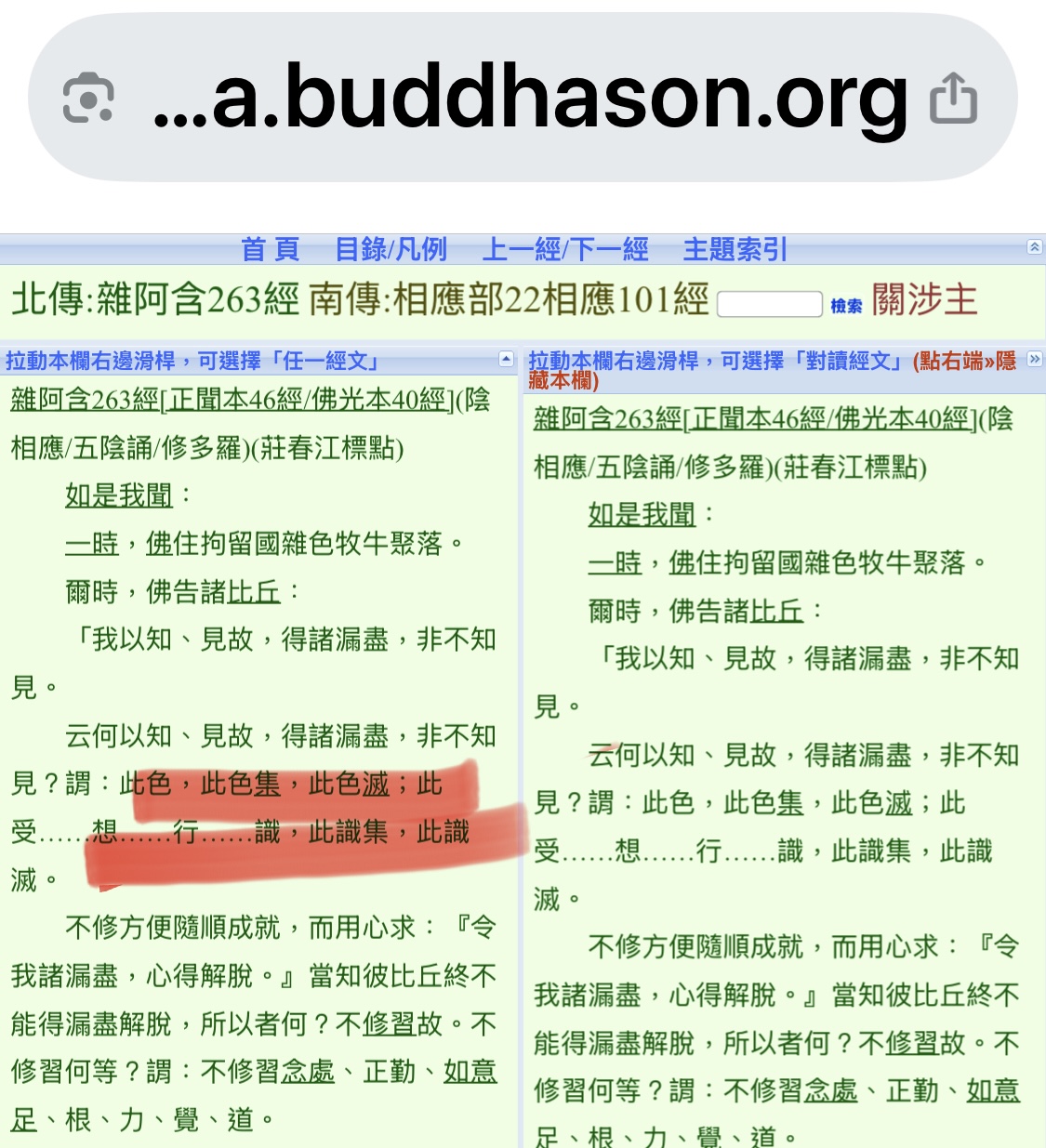無相三昧6-唸佛三昧
台灣已圓寂的廣欽老和尚,
表明祂證入的境界是「唸佛三昧」。
廣老,我是親近過的,其功力在現場目睹只能用震驚不已來形容,
廣老對於我而言是一大啟示,
確認佛法講的證悟世界是存在的,
既使我對「唸佛三昧」無感。哈
廣老除了說「唸佛三昧」、更進一步的指出西方極樂世界,
個人對「唸佛三昧」無感,
但對道行已經這麼高的修行者指出的極樂世界到底存不存在?
渴望做出解答。
這答案包括我個人對佛法的探索所得,不只是書面資料。
如果極樂世界是存在的,
那是修淨土宗有成就的高僧大德們,福報所「變現,」
不是一般人或是一個存在於地球以外的極樂世界。
相較於「無相三昧」,
「唸佛三昧」反而是比較容易達到的,
原因在於修行者不可能把「相」除掉,
反而要分別、辨別「相」去做事才對,
就算超越「相」形,「俗數法」依然存在。
而「唸佛三昧」是專心修持唸佛號到達入定,
先入定再說了!
自佛法傳入華人世界,
「戰亂興淨土,太平興佛法」
ㄧ詞說明佛教在華人世界的現實情況,
我對淨土宗雖然無感,然而面對人性的脆弱,及個人散亂的心緒時,
唸佛號、唸法
(指唸佛法或簡易的《般若心經》)
是一個不錯的選擇。
增加說明「變現」:
如果個人在銀行有存款,
提款出來叫「兌現」。
「變現」;是佛法成就者的福報累積,
如果要表現出來,就是用「變現」形容,
所以極樂世界是修行者福報的「變現」,
只表現在修行者自己的世界裡,
要有同等能量的人才能知道廣老指的極樂世界在哪裡。
馬修·李卡德(Matthieu Ricard)提過他進入「慈悲三昧」時那種「浸在慈悲三昧的喜樂」狀態。
修禪定不見得會喜樂,
所以他修持的「慈悲三昧」會喜樂,
就是他個人的福報變現。
也可以說是修行者在到達成就一個三昧後(非四聖果),
修行者有的自由意志。
在個人成就的三昧裡面看起來就已經非常了不起了,
但如果我們對比「大天五事」,
「大天五事」發生在佛涅槃後才一百年而已!
那時候就已經不知道「阿羅漢果」
長什麼樣子?
但三昧入定卻一直有修行者證入,
可見阿羅漢果到「無色愛」的階段是最困難的思想問題。
思想問題是一般人比較薄弱的,
卻是佛陀教授的佛法最強的項目。
半寄
ps:
(再說一次;
我個人指出耳根可以聽到一切聲音,但要判斷是大腦的事,而傳達還得神經系統正常。
不可能單獨修持耳朵而達到圓通的地步,
人體器官不可能只運作一個。
「請不要說我要消滅淨土宗,太扯了!」
謠言製造機一樣免費,但可怕,
舉個例子:
「破身見」是一個無我的思想集成,
耳+大腦思考才是耳根,
這兩者,如果讀者沒有辦法判別,請託您不要看我的文章🙏。)
以下AI資料 「變現」在佛經中是一個非常重要的術語,尤其常見於大乘佛教經典中,具有特定的宗教意涵。
例子包括: 觀音菩薩三十三應身:應以什麼身得度,即現什麼身。 阿彌陀佛以願力變現極樂世界。」 |
Formless Samādhi 6 – On the Samādhi of Buddha Recitation
The late Taiwanese Chan master, Venerable Guang Qin, declared that he had attained the Samādhi of Buddha Recitation (Nianfo Samādhi).
I had personal contact with Master Guang, and the depth of his spiritual presence was overwhelming—it left me astonished.
He was a major inspiration in my path, confirming for me that the states of realization described in the Dharma are not just theory—they are real.
This was true even though I, personally, felt little emotional connection to Nianfo Samādhi. (Just being honest!)
Beyond describing this samādhi, Master Guang also spoke of the Western Pure Land.
Though I remained unmoved by the method of Buddha recitation, I was deeply curious:
Could the Pure Land described by such an accomplished practitioner actually exist?
The answer I eventually found comes from my own personal Dharma exploration—not merely from scriptural studies.
If the Pure Land does exist, it is not a physical place somewhere in the cosmos.
Rather, it is a manifestation of merit generated by accomplished Pure Land practitioners.
In this sense, it’s not accessible to ordinary people, nor is it a literal world beyond Earth.
In contrast to Formless Samādhi, the Samādhi of Buddha Recitation is relatively easier to attain.
Why? Because it doesn’t require eliminating “appearances”.
Formless Samadhi, on the other hand, requires one to consciously interact with external forms and names, while still functioning according to worldly conditions and appearances.
Nianfo Samādhi is attained by sincerely reciting the Buddha’s name until deep meditative absorption arises.
The essential first step? Attain samādhi.
As a traditional saying goes:
“In wartime, Pure Land practice thrives; in peacetime, Dharma study flourishes.” This captures the historical tendencies of Buddhist practice in the Chinese cultural sphere.
Although I personally have little resonance with Pure Land teachings,
when I find myself emotionally scattered or mentally fatigued,
reciting the Buddha’s name or a simple Dharma text like the *Heart Sutra* provides grounding and clarity.
Clarifying "Manifestation":
Just as withdrawing money from a bank is called “cashing out,”
in Buddhism, manifestation refers to the outward expression of one’s accumulated merit.
The Pure Land, then, is the manifestation of the blessings generated through sincere practice.
It is experienced subjectively, within the inner world of the practitioner.
Only those with similar spiritual attainment can perceive the Pure Land that Master Guang spoke of.
Matthieu Ricard once described the blissful joy he felt while immersed in the Samādhi of Compassion.
Since samādhi doesn’t always involve bliss, the joy he felt was a personal manifestation of his merit.
This reflects the practitioner's freedom of will once a certain level of meditative achievement is reached (even apart from the Four Fruitions).
Such personal attainment may seem extraordinary on its own—
but if we look back at the Five Points of Mahādeva, proposed just 100 years after the Buddha’s passing,
people had already begun to misunderstand what arahantship actually meant.
Yet despite this, samādhi realization has been continually achieved by sincere practitioners through time.
This suggests that the final steps toward arahantship—especially the elimination of “formless craving”—remain the most difficult philosophical and experiential challenges.
Most people struggle in the realm of thought,
yet this is precisely where the Buddha’s teachings are most profound.
Master Banji
PS:
Let me clarify again:
The ear can receive sound, but discrimination happens in the brain, and this requires a functional nervous system.
No single organ can achieve full realization in isolation.
Please don’t claim I seek to “abolish Pure Land Buddhism.” That’s entirely false.
Rumors, though costless, are deeply destructive.
For example, breaking identity view is not just a belief—it’s a cognitive deconstruction of selfhood.
Only when the ear and the thinking brain operate together can hearing occur.
If a reader cannot distinguish this, I kindly suggest you skip my writings 🙏.

